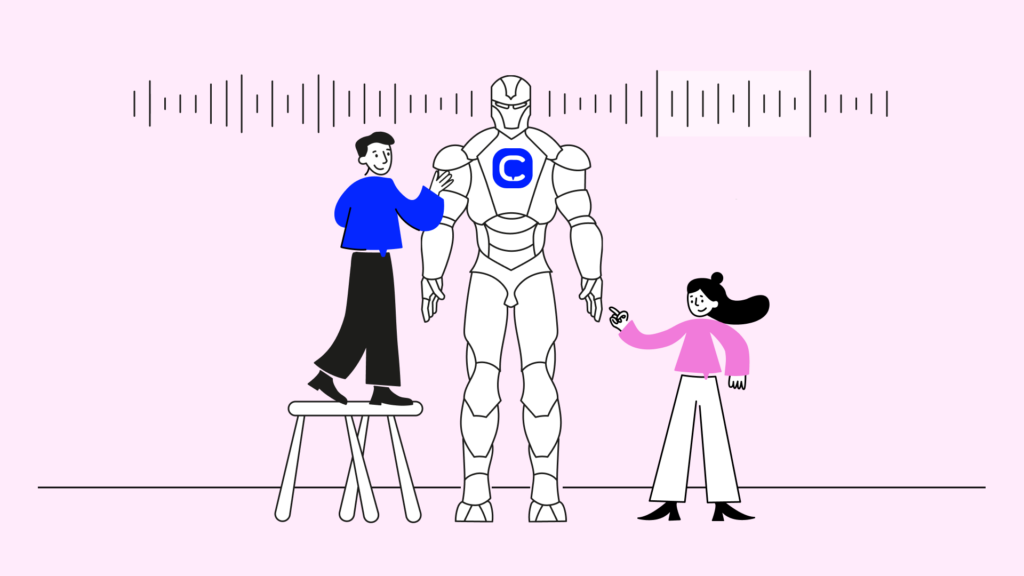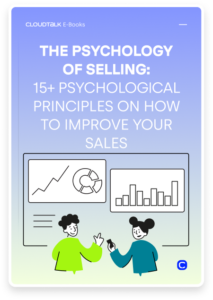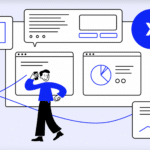Succeeding with AI for Sales: 8 Expert Strategies

There’s only so much a human can do in a day, yet the expectations companies place on their employees seem to grow daily. Faster task completion, quicker issue resolution, more deals closed – these are just a few of the high demands you may encounter, but thankfully, it’s also where AI for sales can help.
AI gives companies and their sales teams access to various advanced features and strategies to help them stay ahead of the curve. And to help you make the most of them, we gathered ten experts from industry frontrunners to share their most effective tips and strategies. Stay tuned as we discuss the place of predictive, adaptive, and conversation AI in our rapidly evolving sales industry.
What Is “AI for Sales”?
As you might expect from the name, “AI for sales” is the umbrella term used to describe various artificial intelligence solutions focused on improving the sales process. Traditionally, they include predictive, adaptive, and conversation AI-enabled tools, like automated sales assistants, chatbots, predictive analytics, and more.
Why Should You Care?
AI helps businesses work more efficiently, create better customer experiences, and increase revenue. But more than that, it makes your employees’ lives easier, just like it does for customers.
By using AI, sales teams can automate all the repetitive tasks that get in the way of doing the work they value and enjoy the most. In that sense, AI for sales helps transform the workplace into a more positive, relaxed environment where people are free to focus on what they do best.
What Are the Benefits of AI for Sales?
Let’s investigate what AI for sales can do for you in more detail. These technologies can offer a wide range of benefits, but primarily, they include higher efficiency, better insights, and improved customer experiences. And so, that’s what we’ll discuss here.
Increased Efficiency
- Process Automation: As mentioned, AI can automate various monotonous and repetitive tasks to unburden sales reps and allow them to focus on what they do best. An AI sales assistant can be particularly useful, as it can automatically manage lead qualification, follow-ups, pipeline management, forecasting, and data entry.
- Streamlined Workflows: By removing automatable tasks from the equation, AI for sales can streamline entire workflows, allowing for unprecedented process efficiency. This effect can be further improved by incorporating automation for CRMs and other tools, ensuring sales reps always have access to all the data they need without extra effort.
- Fewer Errors: Unlike humans, AI doesn’t get tired nor make mistakes (assuming it’s programmed properly). This seemingly small advantage makes for an incredible benefit, as you’ll never have to spend a moment more looking for mistakes in your databases or processes, saving even more time and money.
Better Data Insights
- Data Analysis: Being a machine, AI can run thousands, if not hundreds, of thousands of mathematical operations with incredible accuracy. This allows you to create and access analyses of entire data sets in a very short time.
- Trend Identification: Humans have excellent pattern recognition, but nowadays, so does AI. Adding that to its incredible ability to evaluate vast databases, AI for sales can quickly identify trends and patterns a human would likely miss.
- FImproved Decision-Making: Combining our last two points, we arrive at their logical conclusion and the biggest benefit AI for sales can offer regarding data insights. By breaking down big data sets into comprehensive reports and tracking overarching trends, AI can help employees make better, data-driven decisions and improve overall customer success strategy.
Enhanced Customer Experience
- Personalized Interactions: If you use a CRM, you probably have substantial data regarding your customers and their past interactions. You can make the most of these by tying them with a conversation AI solution, like a chatbot, which can automatically adapt its responses to the customer’s unique needs and preferences.
- Improved Communication: AI solutions like an Interactive Voice Response (IVR) system and chatbots remove the need for customers to wait long for one of your agents to get back to them. They allow for near-immediate communication, improving both engagement and responsiveness.
- Better Customer Service: While AI might lack the capacity for solving complex issues (for now), it’s extremely adept at addressing frequently asked questions and common problems like order status, returns, etc. And since most company-customer interactions consist of these situations, AI for sales allows you to deliver faster, more accurate, and better customer experiences than ever before.
8 Expert Strategies for Maximizing the Benefits of AI for Sales
1. Blue Bowen, Research Principal at G2
1. What are your predictions for the future of AI in Sales?
Given the emergence of generative AI, AI has been used in sales for years and will continue to increase in adoption and expand its functionalities. We will see AI enter into more sales-related functions and further automate tasks. G2’s 2023 Buyer Behavior Report (Source) supported this sentiment, as 81% of respondents noted the software they purchase must have AI functionality. AI will not replace sales reps, as sales will continue to be about relationship building, but it will augment the need for repetitive, manual tasks to allow representatives to focus on high-value, revenue-accelerating tasks.
2. What challenges exist in implementing AI for sales, and how can they be overcome?
There can be various challenges in implementing AI, depending on the type of AI and what aspects of the sales process it will support. The primary challenges relate to what data is being collected, where it is being stored, identifying the risks and inaccuracies associated with the AI output, and how to mitigate them. Additionally, it may be challenging to measure the effectiveness of AI if it is implemented for processes that do not have tangible results.
3. What are your recommendations for successfully implementing AI in the sales process?
Start implementation by identifying inefficient low-value tasks that can be easily optimized. Be cognizant of data and privacy concerns regarding the AI application, particularly for generative AI, and have plans to mitigate the risks. Select AI applications that seamlessly integrate with your existing tech stack to ease implementation and drive higher adoption rates. Ensure applications can be tracked to understand success and adoption rates and mitigate privacy concerns.
2. Bill Vesce, Director of Sales at Beautiful.ai
1. What are your predictions for the future of AI in Sales?
There will be more automation of the tedious tasks of a salesperson to enable more time for pitching and converting prospects. We can expect to see AI sales email writing, automated calling, more precise forecasting, smarter outreach, and AI sales coaching, to name a few.
2. What challenges exist in implementing AI for sales, and how can they be overcome?
Human versus machine approach. AI should be used for time-consuming tasks (like prospecting) rather than areas where the customer expects a human. The challenge is that it’s up to the salesperson to delineate.
3. What are your recommendations for successfully implementing AI in the sales process?
As said above, striking the right balance between human and AI interaction is essential. The best way to implement AI in sales is to allow it to take over the more time-consuming tasks, like prospecting. Meanwhile, salespeople should handle the areas where customers expect a human touch. Ultimately, it’s up to the sales team to correctly differentiate these roles. This strategy will enable companies to capitalize on AI’s efficiency, while still maintaining that personal connection with their customers.
3. Oleg Bilozor, CEO & Founder at Reply
1. What are your predictions for the future of AI in Sales?
We’re already witnessing AI become commonplace in sales – from prospecting and outreach to negotiations or pipeline analytics. However, I don’t see AI replacing salespeople any time soon. On the contrary, it will act as a co-pilot, freeing them from repetitive tasks.
Sales enablement with AI is already transforming how reps engage with customers, recognizing patterns and suggesting the best next steps. The future of sales with AI looks very promising, with increased efficiency and truly personalized experiences.
2. What challenges exist in implementing AI for sales, and how can they be overcome?
I currently see two problems with adopting AI in sales: data privacy and associated costs.
While the latter is far-fetched, as there are tons of affordable or even free tools on the market, the privacy and security closely tied to the ethical aspect of AI should be treated with all seriousness. One way is by adopting certain protocols to handle customer data responsibly and ensure fairness in AI algorithms’ decision-making processes.
3. What are your recommendations for successfully implementing AI in the sales process?
I recommend staying focused with only a few tools and use cases simultaneously. I see too many salespeople getting excited about every new shiny tool that pops out, but they need to catch up on what those tools can do.
AI adoption, especially in customer-facing operations, requires certain consideration. First, focus on one task or activity you’d like to streamline with AI and test the waters with just one tool that’s perfect for the job.
4. Lenka Brozmanova, Chief Marketing Officer at Nicereply
1. What are your predictions for the future of AI in Sales?
Future B2B sales will be shaped significantly by artificial intelligence. For example, OpenAI’s ChatGPT is already transforming how B2B sales teams work. Sales teams can use AI to identify the right leads, personalize their outreach, and automate repetitive tasks.
Artificial intelligence will transform sales by streamlining processes, saving time, and creating a more personalized experience for leads. By automating routine tasks, AI tools will make the sales process more efficient. This will free up reps to spend their time on more impactful tasks, such as creating unique value propositions and providing specialized consulting services for enterprise clients.
AI will have a bright future in B2B sales. Their software will have built-in AI, chatbots will answer customers’ most common questions, and AI tools will assist them with their day-to-day tasks.
2. What challenges exist in implementing AI for sales, and how can they be overcome?
For AI to be effective for sales messaging, you must feed it with high-quality data. Poor input will result in an ineffective output, leaving customers disappointed. Intuition and creativity cannot be replaced by AI, so human oversight is essential. AI models must be tested and optimized to ensure their effectiveness.
3. What are your recommendations for successfully implementing AI in the sales process?
To successfully implement AI in sales, follow these steps:
Implementing AI in sales begins with understanding how it can benefit you. Be clear about what the AI solution will bring to your team.
Choose an AI solution that fits your needs. Sales managers and decision-makers can easily overlook this, despite it seeming obvious. Many tools exist, but only a few are truly useful.
Quality control should be ensured. You can only use AI effectively for sales messaging if the data you feed is high quality.
Human oversight is essential for ensuring the implemented solution does not harm more than good.
Testing and optimizing AI models is also important to ensure their effectiveness.
Finally, human touch & connection are crucial in B2B sales, so use artificial intelligence sparingly.
5. Gaurav Sharma, CEO & Founder at Attrock
1. What are your predictions for the future of AI in Sales?
With AI, you’ll be armed with much data about your prospects and leads. AI-powered sales software could scrape a lot of information about your prospects, which would help you understand what they care about and their potential problems. This would go a long way in customizing your services for them.
AI can also take sales conversations and research to new heights through generative AI-powered communications. Finally, AI will help automate a lot of segments of the sales process involving prospecting to help you determine which prospects are worth pursuing and which ones aren’t.
2. What challenges exist in implementing AI for sales, and how can they be overcome?
Some of the challenges for AI implementation in sales could be:
1. Hallucinations: AI is known to hallucinate, so you still need human oversight.
2. Inconsistent data: While AI can skim through lots of data to give you reliable suggestions, data inconsistency could lead to poor outcomes.
3. Training: Employees may be used to a certain working method. They may have to be trained well to get acquainted with AI-powered sales platforms.
3. What are your recommendations for successfully implementing AI in the sales process?
I’d recommend taking a gradual approach to implementing AI in sales. Here are the steps I’d take:
1. Win employees over: Convince your employees about the need for AI in sales and show them why it’s necessary and how it can help simplify their job.
2. Analyze tools well: You must see which fits your requirements best. These are the ones you should choose.
3. Train employees: Your employees must be upskilled to get acquainted with AI-powered sales tools.
4. Keep your strategy updated: It’s important to constantly update it to ensure you always employ best practices to drive sales with AI.
6. Will Eychaner, Business Development Representative at Dataddo
1. What are your predictions for the future of AI in Sales?
While AI will not replace the need for people occupying sales roles, sales professionals using AI in their work will have a significant advantage over those who do not. Various AI tools have already demonstrated an exceptional ability to reduce the time it takes to do basic manual tasks such as content creation, market research, keyword identification, ICP research and designation, summarization, etc. Whether or not the end results are usable depends on the user’s efficacy and knowledge as well as their ability to apply them productively — once individuals learn how to do this effectively and disseminate the know-how, there will be a tremendous shift in how sales roles operate.
2. What challenges exist in implementing AI for sales, and how can they be overcome?
Knowing which tools could help a business and the specifics on how would be the two most pressing concerns. With so many new tools aimed at so many different departments, it’s easier to determine which ones would be effective by investing a decent amount of time in conducting research. The next issues on the docket would be data quality and availability, followed by the existing integrations between internal systems, databases, apps, and the AI itself. With consistent and complete datasets to draw on, the AI can produce accurate work and the insights the business would need.
3. What are your recommendations for successfully implementing AI in the sales process?
1. Ensure the data the AI pulls from is reliable and clean.
2. Ensure the integrations between your tools and systems are secure and consistently flowing.
3. Understand that adopting the use of AI may actually terrify some people. Approaching this topic with transparency and providing relevant resources and citations to answer the what, how, why, and examples for the question “What do I get out of it?” will be key.
4. Find resources on the internet. They’re everywhere for every role. GPT prompts for sales/outbound/seo identification/content creation etc. Happy to provide resources upon request.
7. Irina Weber, Content Strategist at LawRank
1. What are your predictions for the future of AI in Sales?
I think the changes AI will make will happen quickly and affect every industry in significant, unpredictable ways. The B2B sales profession is no exception.
B2B salespeople can quickly gain deep insights into their customers, automate low-level tasks, and free up more time to spend on the personal, human connections that will continue to be the basis of every sales relationship into the foreseeable future. AI removes human guesswork and intuition from the sales forecasting process. It gives a realistic view of the pipeline and accurate forecasting to help businesses make smarter decisions.
2. What challenges exist in implementing AI for sales, and how can they be overcome?
Implementing AI for sales teams can be a challenge, especially when it comes to training. Sales team members don’t have enough technical skills to use AI effectively, resulting in frustration and lower adoption rates. It also requires changes in current processes and workflows. Some sales team members may reject changes, making it hard to get buy-in for new AI-based tools and techniques.
3. What are your recommendations for successfully implementing AI in sales?
AI for sales is very real, and it’s here to stay. If you want to make better business decisions and train sales reps, you’ll need to adopt new technology for sales into your training process. Start off by assessing your sales training tech and audit your tools for a holistic view of your in-house capacities.
Educate yourself on existing AI sales training tools by reading blog posts, analyst reports, and user reviews to understand the current landscape. Find out where the sales team’s knowledge, skill, and experience gaps lay and conduct meetings by reviewing metrics as a team as part of a larger conversation of deals in progress.
8. David Pawlan, Co-Founder at Aloa
1. What are your predictions for the future of AI in Sales?
AI will help personalize sales to a new level. The process of cold outreach is arduous, and it requires patience and extreme attention to detail. AI will allow sales teams to bypass this process, leveraging AI to fill the funnels and then allowing their sales team to come in and close. That will be the biggest benefit of AI in sales, for at least the immediate future.
2. What challenges exist in implementing AI for sales, and how can they be overcome?
I see a challenge going back to personalization, ensuring that it sounds legitimate and doesn’t feel like a mass AI-enhanced outreach campaign. A prompt engineer’s ability to differentiate their AI results from competitors will be increasingly important.
3. What are your recommendations for successfully implementing AI in sales?
Pay attention to the little details and leverage them as an asset to uplift your process, not replace it. AI should supplement your sales process and enhance your team. It should not be used as a tool to replace your team unequivocally.
Conclusion
In conclusion, the role of AI in customer service is crucial for businesses looking to enhance efficiency, reduce costs, and provide personalized experiences to their customers.
AI-powered solutions like chatbots and virtual assistants can automate routine tasks, offer 24/7 support, and analyze customer data to deliver tailored responses. The benefits for companies include cost savings, improved efficiency, and scalability, while customers enjoy quicker response times, personalization, and self-service options.
Our 8 experts emphasize the importance of using AI to augment human agents rather than replace them and foresee future advancements in natural language processing and machine learning.
As AI continues to evolve, it has the potential to revolutionize customer service by delivering exceptional experiences that combine the strengths of both AI and human agents.
Take a deep dive into the psychology of selling

What did you find in this article?
What are some examples of customer acquisition costs?
Customer acquisition cost (CAC) is the overall expense of sales and marketing to acquire a new customer within a specific timeframe. This includes costs related to various programs and marketing campaigns, salaries, commissions, marketing and sales software, bonuses, and overheads involved in attracting leads, converting them into paying customers and overall increasing sales.
What distinguishes Cost Per Acquisition from Customer Acquisition Cost?
While CAC measures the cost of acquiring a paying customer, Cost Per Acquisition (CPA) measures the cost of acquiring a lead who has taken a desired action, such as signing up for a free trial. CAC gives a holistic view of a business’s relationship with the average paying customer, while CPA is more of a campaign-level metric that examines the cost/profit ratio of particular marketing channels like SEO, PPC, SMS, cold calls, etc. Because of varying factors and costs, each CPA calculation for a marketing channel is its own unique equation.
What is meant by CAC?
Customer acquisition cost (CAC) refers to the cost associated with gaining a new customer. Simply put, CAC refers to the expenses and resources involved in obtaining and approaching new customers. It is a vital metric for businesses and is often used in conjunction with the customer lifetime value (LTV) metric to evaluate the value produced by a new customer. This is why it’s crucial to focus on your marketing and sales alignment.
How do you calculate CAC payback?
To determine the CAC payback period, a business must first calculate its customer acquisition cost (CAC) by collecting information from marketing and sales teams on ad spend, content creation, publishing costs, and department overheads. Once this information has been gathered, divide the total costs by the number of customers gained. This is the average acquisition cost for the business, and now you’ll be able to calculate the CAC payback period.
Therefore, it is important for businesses to ensure their customer approach process is as efficient as possible to operate effectively without exceeding their budget. By doing so, companies can reduce their customer acquisition costs and improve their CAC payback period.
What is the formula for CAC payback?
Calculating the CAC payback period is as simple as taking the customer acquisition cost (CAC) and dividing it by the monthly recurring revenue (MRR). To be profitable and prevent customer churn, you should always treat your customers well and measure overall customer satisfaction to build their loyalty and trust.
What is the difference between customer acquisition and retention costs?
Customer acquisition cost (CAC) is the expense of acquiring a new customer, which includes all expenses involved in attracting and converting a prospect into a paying customer, such as marketing, advertising, sales, and onboarding costs. CAC is a crucial metric for businesses to assess the effectiveness and efficiency of their customer acquisition strategies.
On the other hand, customer retention cost (CRC) is the cost incurred by a company to retain an existing customer. This includes all expenses related to treating customers well and keeping them happy and engaged, such as providing customer support, loyalty programs, and ongoing services. CRC is a significant metric because retaining customers is typically less expensive than acquiring new ones.
In summary, CAC focuses on the costs associated with attracting new customers, while CRC focuses on the costs associated with retaining existing customers.
















